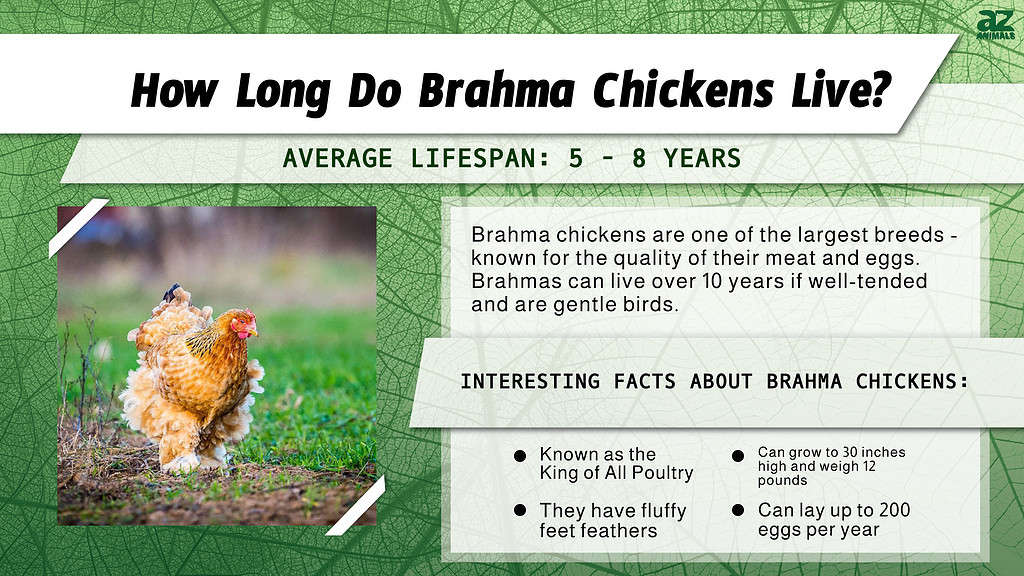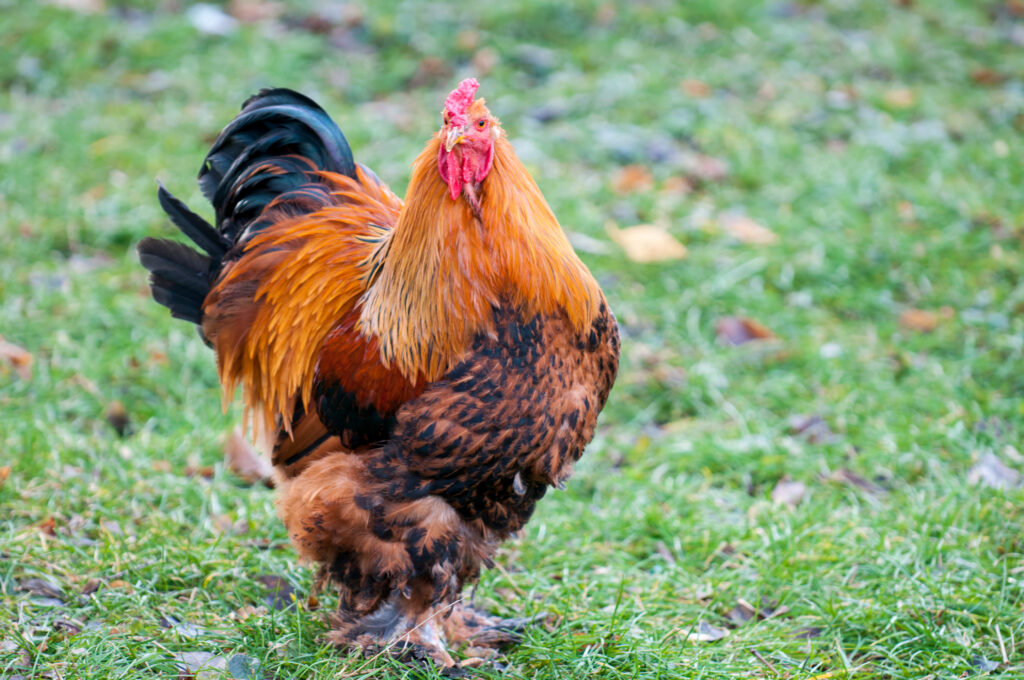Brahma chickens graduated from the Livestock Conservancy’s Conservation Priority List in 2023. They previously moved from the Watch list to the Recovering category in 2016. Their success is mainly attributable to their enormous size and their docile nature. Known as the King of All Poultry, these gentle giants once held a top spot in the poultry trade before their numbers declined. Today they have managed to once again win the hearts of chicken lovers across the world. Their numbers have at last increased to sustainable levels. But just how long do Brahma chickens live? Brahma chickens live an average of five to eight years, exceeding 10 years if well-tended. Read on to learn more about this fascinating breed.

History of the Brahma Chicken
Breeders developed Brahma chickens in the United States in the 1840s. They bred them from Asian fowl, including Cochin chickens and Malay chickens, along with the Chittigong fowl from India. In 1852, George Burnham, an American breeder, gifted some of his prized Brahma chickens to England’s Queen Victoria. The birds became part of the phenomenon known as hen fever, soon fetching outrageously high prices. Brahma chickens became the most popular meat-producing chicken in the United States for around 70 years. However, their popularity declined as the commercial poultry industry took off. The gigantic Brahma chicken was simply too expensive to feed as commercially raised birds.

Brahma chickens, with their heavily feathered feet, are among the largest chickens in the world.
©Yuriy Bartenev/Shutterstock.com
How Big Do Brahma Chickens Get?
Brahma chickens aren’t known as the King of All Poultry for nothing. This breed grows to be one of the largest chickens, reaching heights of up to 30 inches. Today, Brahma roosters reach about 12 pounds, while hens can attain weights of up to 10 pounds. Historically, though, the breed was even larger. Around the turn of the 20th century, roosters routinely exceeded 18 pounds, and hens reached weights up to 14 pounds. Bantam-sized Brahma chickens weigh between 2 to 3 pounds. This is actually smaller than the bantam sizes of several other breeds.

Brahma roosters can reach 12 pounds or more, while hens can weigh up to 10 pounds.
©Patri Sierra/Shutterstock.com
What do Brahma Chickens Look Like?
The massive Brahma chicken looks even larger than its weight would suggest. Brahma chickens have dense and abundant feathers. They have a very fluffy appearance, with feathers that extend all the way down their legs and cover their yellow feet. They have relatively short tails that they hold upright, giving their body almost a V-shaped silhouette.
Brahma chickens have a bright red pea comb. This short type of comb has three small ridges running from front to back. The middle ridge stands just a little bit higher than the ones on the outside. They also have a bright red wattle, red earlobes, and a short, strong beak. Their eyes are reddish brown.
How Well Do Brahma Chickens Lay?

Big, beautiful Brahma chickens lay eggs all through the winter.
©Jpr03/iStock via Getty Images
Brahma hens are moderately good egg producers known for laying exceptionally well during the winter months. They produce up to 200 medium to large size, light brown eggs per year, laying more eggs from October through May. Hens occasionally go broody, but they have some difficulty successfully incubating their eggs due to their size and weight. Hens reportedly do not begin laying until they reach about 6 to 7 months of age, a couple of months later than many other breeds.
Do Brahma Chickens Produce Good Meat?
Brahma chickens are well known for producing good quality meat. From about the 1850s to the 1930s, this breed was the most popular meat-producing chicken in the United States. They grew slowly but reached enormous sizes. Roosters could grow to the size of turkeys, reaching a solid 18 pounds or more. Today, the Brahma chicken is smaller than its vintage variety.
Depending on how long Brahma chickens live, feeding them can prove cost-prohibitive. However, the breed produces large quantities of high-quality, succulent meat that merits the price if owners harvest roosters upon maturity. Breeders often harvest hens as well, once their egg production declines. At weights of up to 10 pounds, the hens outweigh roosters of many other breeds and make good table birds, as well as excellent soup.
Are Brahma Chickens Hardy Birds?
Brahma chickens are very hardy birds that are relatively easy to care for. Their gentle, docile nature makes them well-suited for families and novice breeders. These chickens handle the cold quite well, although they have trouble with wet conditions due to the feathers on their legs and feet. They can have a hard time handling excessive heat due to their size and abundant feathers.
Brahma chickens do not fly or run well, and because the roosters are particularly calm and friendly, they do not fare well against predators. Owners should take care to provide secure coops and enclosures, not so much to keep Brahma chickens in but to keep predators out. Taking good care of your flock and protecting them from temperature extremes can increase how long Brahma chickens live.
The photo featured at the top of this post is © Yuriy Bartenev/Shutterstock.com
Thank you for reading! Have some feedback for us? Contact the AZ Animals editorial team.







